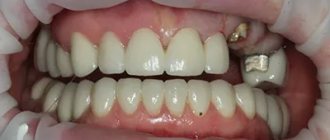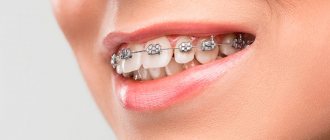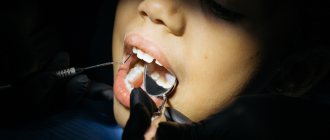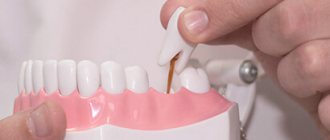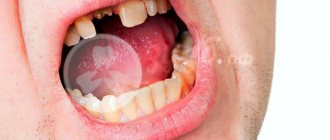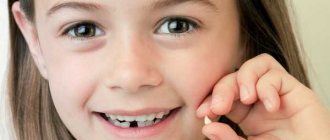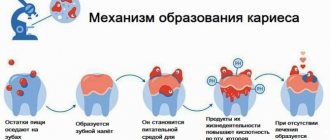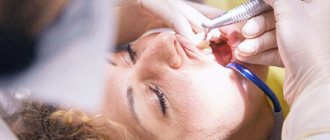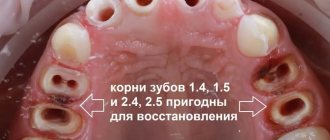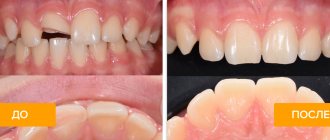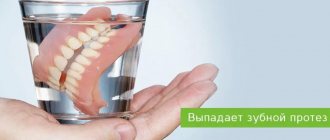Injuries to teeth and gums are common among children of all ages. If a child breaks a baby tooth, then first of all you need to remain calm and competently provide pre-medical care, while trying not to scare the baby. Most often, children are injured when they accidentally fall or when trying to chew hard food or an object. Therefore, children of primary preschool age, who are not yet accustomed to being careful, are most at risk; they may fall hard on the playground or injure their oral cavity with a foreign object.
Symptoms
To suspect that a child has broken a front tooth is quite simple:
- Violation of the shape and integrity of the dental crown. Upon examination, you may notice a chipped tooth and a defect;
- Appearance of a crack. Characteristic of an incomplete fracture, part of the tooth may wobble, but not break off;
- Strong pain. The pain can be localized in the tooth, gum, or even spread to the entire jaw, depending on the severity and nature of the injury. Pain in the jaw occurs with impacted fractures, which are most often the result of trauma. Young children who cannot say what happened begin to cry and refuse food;
- Swelling, redness, bleeding of the gums. In some cases, the fracture is also accompanied by injuries to the soft tissues of the oral cavity. In severe cases, pathological mobility of adjacent teeth may appear.
The child has a dislocated tooth, a severe bruise, and mobility.
In this case, the baby does not allow you to touch or put pressure on the tooth. The damaged unit makes it difficult to close the mouth. The pain is acute and does not go away without anesthetics.
Take your child to the clinic without delay. The dentist will take an x-ray to rule out damage to the roots and pulp. If the tooth remains in the socket, he will fix the position and apply a splint. When the tooth is completely knocked out, it will perform replantation (install it back into the hole). The pulp dies. But the implantation of a natural tooth is still better than its complete loss and replacement with an artificial one.
The root of a permanent tooth is broken.
Mostly the child complains of pain when biting or pressing on a tooth. Mobility and swelling of the gums appear. The fracture site is clearly visible on x-ray.
Therapy requires precise determination of the location of the fracture (upper, middle part, longitudinal fracture) and the presence of inflammation. Treatment methods depend on these parameters. As a last resort, we recommend tooth extraction. Before the procedure, the doctor, together with the parents, will decide how the empty area will be restored. A child's lost tooth can be replaced with a removable denture.
Prices for children's fillings and dental treatment
Features of dental restoration in children
Children's restoration is temporary, designed to last a couple of years until the bite changes. Since nothing should interfere with the proper growth and formation of permanent teeth.
For this reason, fixed dentures, crowns and veneers are not installed in children. They are limited to removable structures, they are easy to replace and adjust to the growing jaw.
At Idealdent, to restore a child’s tooth we use:
Removable prosthetics – plate dentures, butterfly dentures.
Young children are curious about dentures and quickly get used to them. They do not cause fear or psychological discomfort. Temporary orthopedic structures must be replaced every 8-10 months up to 10 years, and every year or two up to 18 years.
Removable dentures are good because:
- evenly distribute the load on the jaw;
- stimulate the development of bone tissue in toothless areas;
- maintain articulatory balance and smile aesthetics.
- Orthodontic treatment – preventive removable appliances with springs, sliding screws, bite pads and other elements.
Applicable at an early age. From 11-14 years old, braces are installed.
The braces system will allow you to correctly move your teeth and close the void. The duration of treatment depends on the clinical case. Usually, by the age of 16, jaw growth stops, braces remain, but the tactics for correcting the bite change.
Dental implantation in children.
Possible only after the final formation of the jaws by the age of 16-18.
What complications can there be?
The main complications of fractures of primary teeth are:
- Formation of a malocclusion (if a broken tooth has fallen out or been removed);
- Pulpitis. Damage to the enamel and tooth crown facilitates the penetration of pathogenic microorganisms into the pulp, where after some time an inflammatory process can develop;
- Periodontal abscess, phlegmon, osteomyelitis and other purulent complications. They are a consequence of advanced infection after tooth trauma.
If a child breaks his molar front teeth, it is important to make sure that the roots of the teeth are not damaged. Injury or fracture of the root of a permanent tooth is dangerous because the tooth may have to be removed from the roots, and expensive implantation will be required to restore the dentition.
Treatment methods
Broken permanent tooth.
First of all, the dentist will assess the extent of the damage and the condition of the pulp.
Possible chipping of enamel or crown at the dentin level. In such situations, the pulp is not affected; children complain only of visible defects in the hard tissues. But a tooth fracture in a child within the dentin or the entire crown causes pain while eating, scratches the tongue, lips and cheeks.
Treatment:
- The dentist sands down the sharp edges and coats the surface with a remineralizing agent. Without opening the pulp, a filling made of composite materials is applied to the fracture site;
- if you find a fragment and bring it in saline solution, the doctor will restore the tooth fragments. This method is preferable - it ensures precise contact with the bite, and there is no shrinkage or change in color of the crown over time;
- a large part of the tooth broke off and could not be found - the dentist will perform a restoration. Recreates the anatomical structure and ideal fit to antagonist teeth. This is necessary for chewing and proper jaw development.
- The tooth is broken, the pulp and nerve are visible.
It is important to contact a specialist within 24 hours to preserve the pulp. Then the tooth will continue to grow and become stronger. And for a doctor this is a primary task.
If the pulp cannot be saved, the dentist will clean out the canals, seal it securely, and place a filling or crown.
Broken baby tooth.
Baby teeth usually need to be removed. The main thing for the doctor is to preserve the germ of a permanent tooth. If a baby tooth is broken within the dentin, the specialist will restore it with a composite material and polish small chips.
It is worth understanding that premature removal of baby teeth leads to early eruption of permanent teeth. Neighboring teeth shift towards the resulting space, causing curvature of the dentition. Therefore, the removal of two or more consecutive primary teeth is an indication for orthodontic treatment using removable and fixed appliances.
Learn more about the treatment of baby teeth.
How are they treated?
The dentist determines treatment tactics depending on the severity of the injury and the condition of the tooth. The following methods are used:
- Tooth restoration. Suitable only in cases where a small piece of the tooth has broken off and the pulp is not involved in the pathological process. Various types of composite materials are used to restore the integrity and normal appearance of the tooth;
- Depulpation. This procedure is used for more severe fractures when the child has symptoms of pulpitis. The process removes the infected pulp, which allows you to save the tooth and prevent the child from developing a malocclusion;
- Delete. A radical measure that is used in cases where it is no longer possible to save the tooth.
If a child knocks out a baby tooth, what should you do?
In a situation where a child breaks a tooth at the age of 1, there is no need to panic. You need to calm the child, pick him up, examine the oral cavity and try to find a broken or knocked out tooth. If it comes out intact with the root, it is necessary to protect the wound from infection by applying a sterile swab. For prevention, you should see a dentist. If a small piece is broken off, and even more so a red dot is visible, you need to immediately go to the dentist and have treatment. The procedure will be similar for older children with trauma to their baby teeth.
First aid
If you see a small chip on a tooth, but nothing bothers your child, then make an appointment with the dentist as planned. Many parents do not know what to do if their child breaks a front molar. Your actions should depend on the child's condition. If there is bleeding from the gums and severe pain, then you need to immediately go to the nearest dental clinic to see a doctor. If there is slight pain, but overall health is not affected, then you can give an anti-inflammatory drug (for example, paracetamol) in an age-appropriate dosage and make an appointment with a doctor the next day.
Prevention of childhood dental injuries
First of all, it is important to instill in children a sense of caution from an early age. You should teach your child to fall safely, placing his hands correctly, and to take care of especially vulnerable places. When playing sports, you should use a helmet to avoid injury. It will protect not only your head, but also your teeth. If the helmet is not provided for by the uniform, you can get by with a mouth guard. It is recommended to order a mouthguard individually based on impressions of the child’s teeth, then it will accurately replicate the anatomy of the jaw and reliably protect against damage.
What to do in the first minutes if a child has a broken tooth?
First, calm down yourself and calm your child. If you have something cold on hand, it is good to immediately apply a compress to the injury site to relieve pain and prevent severe swelling (if the injury is not open).
For an open wound, clean it of large contaminants and cover it with a sterile gauze pad. Time is very important! The most important thing is to get to the dentist as quickly as possible! The doctor will conduct an examination, take an x-ray to see all damage to the hard and soft tissues surrounding the tooth and rule out a fracture of the jaw bones, as well as carry out the necessary treatment.
In the future, such teeth require dynamic observation at a time determined by the dentist. With timely treatment and regular monitoring, the prognosis is favorable.
What to do if a tooth is fractured?
If the injury occurred due to a fall or collision of the jaw with a heavy object, you should make sure that only the tooth is broken, and not the entire jaw. Signs of a broken jaw:
- sharp, persistent pain;
- obvious violation of diction;
- loss of sensation in the lower part of the face;
- inability to open your mouth wide.
Such conditions require an immediate visit to the doctor, even if only one symptom appears. Before visiting the hospital, you need to secure your jaw with a bandage, so as not to aggravate the fracture along the way. If it’s just a tooth problem, you shouldn’t delay your visit to the dentist either. Since an injured tooth can become inflamed, cause discomfort and deformation of the dentition, as well as provoke a fracture of another tooth.
Restoration of injured central incisors in children
Injuries to the anterior teeth of the upper jaw are a common occurrence in children. There are several ways to treat this problem. The consequences of this type of injury can vary from a simple crack to complete avulsion of the tooth. It depends on the severity and nature of the injury. Causes of injury may include playground incidents, fights, or falls. In modern aesthetic dentistry, restorations of the anterior teeth cause the greatest difficulties.
There are several ways to treat and restore chipped front teeth. The choice depends on the dentist's point of view and his knowledge in the field of aesthetic dentistry. In recent years, significant progress has been made in the field of aesthetics and physical properties of composite materials.
Thanks to this, as well as improved techniques such as layering techniques, dentists are now able to imitate the natural appearance of the dentition with direct esthetic restorations. A wide range of enamel shades has also been created, giving dentists the ability to control the degree of translucency and opacity of these types of restorations during minimally invasive procedures. The preserved tooth fragment can be used for its restoration. In this case, a good aesthetic result is achieved.
Today, dentists can perform restorations and achieve aesthetic results using bonding techniques. If the crack is close to the pulp or the pulp is exposed, the dentist may perform endodontic treatment followed by the installation of a post and crown. You may opt for pulp capping with a crown, porcelain veneer, or direct composite restoration.
In children aged 7-8 years with mixed dentition, large pulp canals with open apices are often found. This is explained by the incompleteness of the development of the dentition. At this stage, the occlusal plane, as well as the position of the teeth and soft tissues, are unstable. They are at the stage of formation. Once completed, it is expected that ideal treatment can be carried out. Age is an important factor in choosing the optimal restoration method. If options exist, children should be treated conservatively until they reach an appropriate age.
Clinical case 1.
The patient, a 7-year-old boy, chipped one third of his incisor as a result of a fall (Figure 1). The father took the child to the family dentist. The treatment plan he proposed seemed overly aggressive to the man (as a child, he had a negative experience of dental treatment for a similar injury). Given his son's age, the man felt a more conservative approach was best. Father and son were referred to my clinic for consultation. The man provided one x-ray, as well as a chipped fragment of the 9th tooth in a plastic bag.
Photo 1. Photo before surgery
Photo 2. Smile before surgery, chipped 9th tooth.
Diagnostics.
Clinical examination and review of one periapical radiograph revealed no pulp exposure. A diastema was observed between teeth 8 and 9, with tooth 9 tilted towards the buccal surface. An examination of the bite revealed the absence of occlusal contacts between the anterior teeth of the upper and lower jaw. The final position of the teeth, bite plane and soft tissues have not yet formed. Therefore, treatment options have been limited to the most conservative, minimally invasive procedures. After examining and cleaning the fragment, it was installed in place. Checked compatibility. To stabilize the fragment while the bond formed, a mastic stent with vinyl polysiloxane was made (Photo 3).
Photo 3. Checking the compatibility of the fragment.
After taking scans and photographs, taking into account the age of the child, his father was offered the following treatment options:
* Restoration of a chipped tooth using a light-curing composite
* Making a ceramic veneer (at this age this method is not recommended due to the changing size of the tooth and the development of soft tissues)
* Reattachment of tooth fragment
Treatment plan.
Due to the absence of symptoms, treatment was started without anesthesia. The dentin of the tooth and the fragment was cleaned with pumice, washed and dried. The tooth and fragment were disinfected in a surgical scrub with 2% chlorhexidine gluconate for 60 seconds. They were then washed, placed in a 5% sodium hypochloride solution and washed again.
After this procedure, the surgical field was isolated with cotton swabs. To increase bond strength and minimize microleakage, a full etching technique was used. The dentin and enamel surfaces of the chip and tooth were etched separately for 15 seconds using Ultra-Etch (Ultradent; South Jordan, UT) 35% with phosphoric acid (Ultradent), rinsed, then dentin primer and adhesive (ClearFil SE Bond) were applied J. Morita; Irvine, California), thinned with a blower and light cured for 15 seconds. To stabilize the position of the fragment while the bond was being formed, a stent was placed on the lingual surface of the tooth. The liner and dual-cure composite activator (Insure, Cosmedent; Chicago, IL) were then mixed and a small amount applied to both surfaces. The fragment was put in place. Excess composite was removed using a brush. Photopolymerization was carried out for 30 seconds. The stent was carefully removed; the lingual surface was cured for 30 seconds; this was followed by facial and lingual curing for 60 seconds.
The effects of trauma to the front teeth can range from simple cracking to complete avulsion, depending on the severity and nature of the injury. To increase the bond strength and durability of these types of restorations in children, it is recommended to apply excess composite along the fracture line. In this case, as mentioned earlier, due to the lack of occlusal contact between the maxillary and mandibular anterior teeth, a layer of hybrid composite was applied a few millimeters above the fracture line towards the lingual edge of the incisor, followed by light curing. A thin layer of light-curing clear composite was applied to the facial fracture line (Figure 4).
Photo 4. The fragment after bonding.
Grinding and polishing.
To ensure natural anatomy and structure of the tooth, a transparent composite was applied to its facial surface. Natural gloss on the facial and lingual surfaces of the teeth was provided by polishing strips. Flexi Disks (Cosmedent) followed by composite polishing paste were used to polish the face surface. Ball-shaped finishing diamond burs (Brasseler; Savannah, GA) were used on the lingual surface to create the desired structure. Finishing discs (Cosmedent) were then used followed by the application of a composite polishing paste. Occlusion was checked using various jaw movements to correct unstable contacts. The result was extremely satisfactory for the patient and his parents. The patient was scheduled for a postoperative visit within a few weeks (Figure 5).
Photo 5. View after treatment.
Clinical case 2.
This 11-year-old boy came to the clinic with his mother for the restoration of one third of the 9th tooth (Photo 6). The cause of the injury was a fall in the shower. Unlike the first case, the fragment of tooth 9 was lost. The patient's mother's request was high-quality conservative restorative treatment to restore the teeth to their natural appearance. Thanks to the improvement of the composition of modern composite materials, clinicians have at their disposal a variety of shades that can be used to create aesthetic restorations.
Photo 6. Case 2, view before surgery, chipped tooth 9. The fragment is lost.
Photo 7. Case 2, view of the smile before surgery, chipped tooth 9.
Diagnostics.
Clinical examination revealed no signs or symptoms of TMJ syndrome or malocclusion. Radiographs and clinical examination revealed no pulp pathologies. A diastema with minimal restoration was observed between teeth 8 and 9. There were no signs of a fracture of the 8th tooth.
Treatment plan.
After a complete clinical examination, an alginate impression was made, from which a study model was made for a diagnostic wax-up. Due to the loss of the fragment, the patient was offered a composite restoration. Considering the boy’s age, restoring teeth with ceramic veneers was not the best option. The patient's parents approved the proposed treatment option.
Before restoration, the tooth was cleaned with pumice and disinfected with chlorhexidine. Then we selected shades of Renamel Microfil composite (Cosmedent) and a hybrid composite to restore enamel and dentin. For the initial preparation, a round-head diamond bur (Brasseler) was used with a 2-mm lingual reduction with a deep and long bevel of 2-3 mm along the borders of the facial and lingual surfaces. To increase adhesion strength and minimize microleakage, complete etching was performed. The labial and lingual surfaces were etched for 15 seconds with 37% phosphoric acid, followed by 10 seconds of rinsing and drying. Clearfil SE-BOND adhesive (Kurary America, New York, NY) was applied to the facial and lingual surfaces. The material was then air thinned and light cured according to the manufacturer's instructions. To restore the lost fragment, a three-increment technique (dentin-enamel-incisor [Cosmedent]) was used. Renamel hybrid composite shade B1 was used to restore the lingual wall. To cover the edge of the bevel, a thin layer of opaque material was applied, followed by light curing.
Photo 8. Restoration of chipped tooth 9 with a composite material with microfiller.
Microfilled composite shade B1 was applied to the entire surface of the composite and tooth. An IPC spatula (Cosmedent) was used to create a random bevel and groove for the incisal composite. Then light curing was carried out. The groove is moistened using the composite, and compaction is carried out to ensure incisal transparency. Next comes curing.
Grinding and polishing.
The surface texture and final shape and function of the restoration are achieved through careful grinding and polishing. In this case, discs, crowns and contacts were used separately. Final polishing was carried out using a composite polishing paste (Cosmedent). The finished restoration looked like a real tooth (Photo 9).
Photo 9. Enlarged view of the finished restoration.
Conclusion.
Provided that the fragment is preserved and its integrity, it is possible to bond a chipped front tooth of the upper jaw with excellent results. In a short time, the fragment can be disinfected and secured in place using a dual-cure composite (Case 1). In cases of chip loss where a significant portion of the tooth is intact, conservative restorative treatment with direct esthetic composite as described in Case 2 is possible and is usually an excellent option for young patients (Figures 10 and 11).
Photo 10. View after surgery.
Photo 11. View after surgery.
Author: Khalil S. Saghezhi, DDS
Damage to hard dental tissues
- Ifraction of enamel. It is a crack on the surface of the tooth without loss of dental tissue.
- Fracture within the enamel. Belongs to the category of chips without complications, but with the loss of some tissue.
- Enamel-dentin fracture. The fracture has no complications, and is distinguished by the passage of the chip line simultaneously along the enamel and dentin. Part of the dental tissue is lost.
- Enamel-dentin-pulp fracture. Refers to the number of fractures with complications, which result in exposure of the pulp.
Types of root fractures
Dentists call several types of dental fractures:
- Transverse
(horizontal). The fracture is parallel to the cutting edge or chewing area. - Vertical
(longitudinal). Extent along the longitudinal axis of the crown. - Oblique
- a variant of the vertical one. The contour is at an angle to the tooth axis. - Splintered
. The presence of several fault lines.
The type of defect is visible in the picture. In the last two cases, removal is indicated, but in the first, there is a chance to restore the tooth.
Transverse fracture
The level of fracture and unit loosening varies. If the root of the tooth is broken in the apex area, then mobility is minimal. The intensity of the symptoms is determined by the damage to the pulp: when the integrity of the neurovascular bundle is damaged, sharp pain impulses will follow after pressing or biting. Is the fracture line in the middle of the root? The mobility is palpable.
Vertical root fracture
Such a tooth root fracture is difficult to diagnose in the early stages, but the clinic has advanced equipment that allows us to identify the defect. Previously, such a diagnosis was fatal, but in some episodes (for example, an incomplete fracture - a crack in the root of a tooth), restoration is possible with the help of special composite cements or innovative compositions. But in most cases, a longitudinal root fracture means that the tooth must be removed followed by implantation or other prosthetics.
Implantation
Sometimes in a dentist’s practice there are more serious cases, for example, when a patient breaks two front teeth and damages the roots. In such situations, the restoration methods described above will not be able to give the desired result, so a more radical method is used - dental implantation. With its help, not only the visible part of the tooth is restored, but also the root itself, the role of which is played by the implant. Today there is a wide variety of implants, from budget to premium, but all of them are designed to perform the most important function - to transfer the chewing load to the bone, which will significantly reduce the rate of its atrophy.
Dental implantation takes place in a certain sequence and includes the following stages:
- Examination (visual inspection, targeted and panoramic photographs, etc.) and consultation.
- Implant installation.
- Installation of the gum former.
- Crown installation.
The steps described above can be performed in one or two stages, but the final result can only be discussed after the implant has completely engrafted. This process can take from several months to six months.
In cases where the patient does not go to the dentist for a long time and does not restore the broken front tooth, the bone tissue gradually atrophies (resorbs) due to lack of load. In the upper jaw, this process is faster, since the bone in this area is porous and more easily susceptible to irreversible changes. Sooner or later it will become thinner to such an extent that it will be impossible to install an implant. In such situations, another operation is performed - bone grafting, which allows you to increase the missing volume. However, in this case more time and financial resources will have to be spent on rehabilitation. Therefore, you should not ignore the problem; it needs to be resolved in a timely manner by a good dentist.
